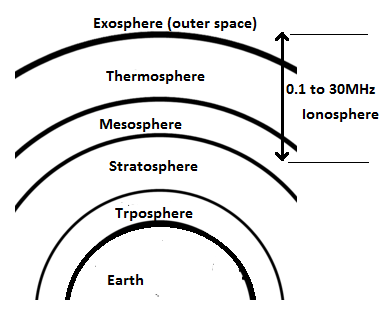Answer
396.9k+ views
Hint: We have to use the idea of critical frequency for the ionosphere. Critical frequency is defined as the frequency above which the waves penetrate the ionosphere and below which the waves are reflected back from the ionosphere. Electron density is defined as the measure of the probability of the presence of an electron at an infinitesimal element of space surrounding any given point.
Complete step-by-step solution
We should know that critical frequency is defined as the frequency above which the waves penetrate the ionosphere and below which the waves are reflected back from the ionosphere. Critical frequency is also called limiting frequency.
We know that the maximum electron density of the ionosphere is given by the following relation:-
${{f}_{c.}}=9\sqrt{{{N}_{\max }}}$ . Which can also be written as ${{f}_{c}}=9N_{\max }^{\dfrac{1}{2}}$. Where ${{f}_{c}}$ denotes critical frequency and ${{N}_{\max }}$ denotes electron density per ${{m}^{3}}$ . The Ionosphere transmits a range of frequencies between \[0.1\] to $30MHz$ .
Therefore, from the above given options only option $(C)$is correct.
Additional Information:
The ionized part of earth’s upper atmosphere is called the ionosphere. This region includes the thermosphere, parts of the exosphere and mesosphere. The source for ionization for the ionosphere is solar radiation. Radio propagation is influenced by the ionosphere to far places on earth and therefore it has very high importance. It is from $48km$ to $965km$ in the atmosphere. We have following diagram to show the different layers of the atmosphere:-

Note: We should remember the fact that the ionosphere is not a separate layer of atmosphere but the space in the thermosphere, parts of the exosphere, and mesosphere which is ionized in nature. It should be noted that below critical frequency radio waves are reflected by the ionosphere. The Ionosphere is composed of electrons and electrically charged atoms and molecules that surround the earth.
Complete step-by-step solution
We should know that critical frequency is defined as the frequency above which the waves penetrate the ionosphere and below which the waves are reflected back from the ionosphere. Critical frequency is also called limiting frequency.
We know that the maximum electron density of the ionosphere is given by the following relation:-
${{f}_{c.}}=9\sqrt{{{N}_{\max }}}$ . Which can also be written as ${{f}_{c}}=9N_{\max }^{\dfrac{1}{2}}$. Where ${{f}_{c}}$ denotes critical frequency and ${{N}_{\max }}$ denotes electron density per ${{m}^{3}}$ . The Ionosphere transmits a range of frequencies between \[0.1\] to $30MHz$ .
Therefore, from the above given options only option $(C)$is correct.
Additional Information:
The ionized part of earth’s upper atmosphere is called the ionosphere. This region includes the thermosphere, parts of the exosphere and mesosphere. The source for ionization for the ionosphere is solar radiation. Radio propagation is influenced by the ionosphere to far places on earth and therefore it has very high importance. It is from $48km$ to $965km$ in the atmosphere. We have following diagram to show the different layers of the atmosphere:-

Note: We should remember the fact that the ionosphere is not a separate layer of atmosphere but the space in the thermosphere, parts of the exosphere, and mesosphere which is ionized in nature. It should be noted that below critical frequency radio waves are reflected by the ionosphere. The Ionosphere is composed of electrons and electrically charged atoms and molecules that surround the earth.
Recently Updated Pages
How many sigma and pi bonds are present in HCequiv class 11 chemistry CBSE

Why Are Noble Gases NonReactive class 11 chemistry CBSE

Let X and Y be the sets of all positive divisors of class 11 maths CBSE

Let x and y be 2 real numbers which satisfy the equations class 11 maths CBSE

Let x 4log 2sqrt 9k 1 + 7 and y dfrac132log 2sqrt5 class 11 maths CBSE

Let x22ax+b20 and x22bx+a20 be two equations Then the class 11 maths CBSE

Trending doubts
Fill the blanks with the suitable prepositions 1 The class 9 english CBSE

At which age domestication of animals started A Neolithic class 11 social science CBSE

Which are the Top 10 Largest Countries of the World?

Give 10 examples for herbs , shrubs , climbers , creepers

Difference between Prokaryotic cell and Eukaryotic class 11 biology CBSE

Difference Between Plant Cell and Animal Cell

Write a letter to the principal requesting him to grant class 10 english CBSE

Change the following sentences into negative and interrogative class 10 english CBSE

Fill in the blanks A 1 lakh ten thousand B 1 million class 9 maths CBSE



